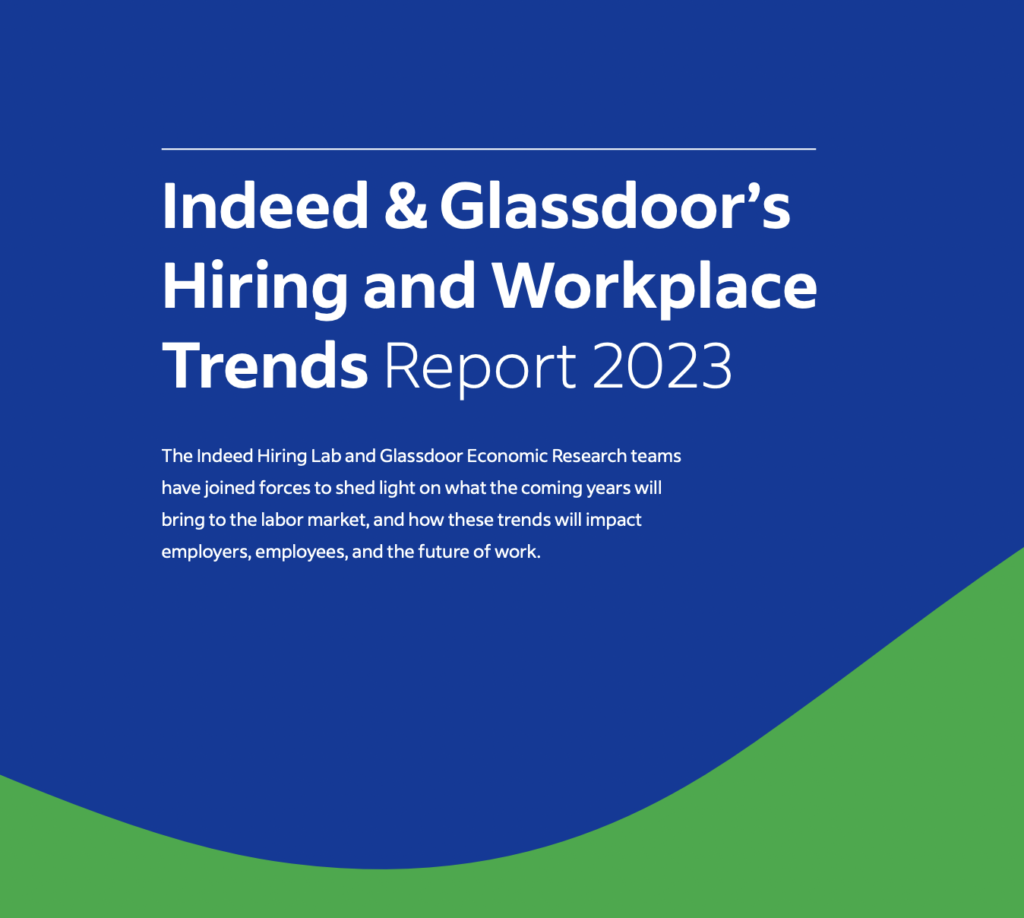Key Points:
- The share of US job postings on Indeed advertising employer-provided salary information more than doubled between February 2020 and February 2023, rising from 18.4% to 43.7%.
- Pay transparency has risen significantly in the past year, driven in part by new regulations requiring disclosure in job postings, but we observed an increase even in areas without these pay disclosure requirements.
- Salary visibility in job postings is lowest in the South, which accounted for 18 of the 20 least transparent metro areas.
- Over the last year, pay transparency has grown the fastest in high-wage occupations like software development, mathematics, and banking and finance.
More than 40% of US job postings on Indeed now include employer-provided salary information, an increase of 137% in the last three years, due in large part to the introduction of transparency legislation and the tight US labor market—and the trend continues to rise. Despite the overall increase in salary visibility in postings, the numbers vary significantly based on geography and occupation. Let’s break it down.
Salary transparency tends to be highest in the West, where regulations are more common, and lowest in the South. Job postings for roles in childcare, security and public safety, and the dental fields are the most transparent, while positions in engineering and banking and finance typically offer less salary information in postings. Over the last year, the most significant rise in transparency has occurred in high-wage jobs, which have historically provided less pay information upfront.
Pay transparency has risen significantly in recent years
In 2019, Colorado passed legislation to combat pay disparities—particularly for those based on sex or race—requiring employers to include salary information in job postings starting Jan 1, 2021. When the bill passed, only about 16% of US job postings provided salary information. Since then, California, Washington, and New York City have enacted similar requirements, with the rest of New York state expected to follow later this year.
Given these laws and growing public interest in the topic, it’s no surprise the percentage of job postings with salary information has started to increase. In February 2020, 18.4% of postings on Indeed provided pay information. By February 2023, that number had more than doubled, climbing to 43.7%.
While rising transparency can be attributed somewhat to new laws, it also appears to have been pushed up by the tight US labor market. Previous Hiring Lab research suggested that higher rates of benefit advertisement in job postings reflected market trends. Along those same lines, employers may also be willing to provide more salary information to attract workers.
Growth in transparency may also be partially attributable to the rise in remote work, since many state regulations apply to firms that employ at least one worker in their state, even if that position is remote. As a result, providing salary information in job postings is vital for employers who want to avoid losing access to workers in regulated areas.
Pay transparency is highest in areas with disclosure requirements
Pay transparency laws appear to work, leading to more salary visibility in local job postings—all 10 of the most transparent metro markets nationwide are in states covered by disclosure laws. At the top of the list are Colorado’s two largest metros, Denver-Aurora-Lakewood and Colorado Springs, with approximately 77% and 75% of job listings in those areas featuring salary information, respectively.
Given the length of time that Colorado’s laws have been in place, it isn’t surprising to see those metros at the top of the list of markets with the highest overall shares of salary-transparent postings. But over the past year, metros that recently put regulations into effect have experienced the fastest growth in transparency. Eight of the 10 metro areas with the fastest growth in transparency are in California, where regulations took effect on January 1, 2023. The share of salary-transparent listings has more than doubled in all 10 of the fastest-growing metros and has more than tripled in the San Jose metro area, the heart of Silicon Valley.
Pay transparency is rising even in areas without regulation
Even in areas without active salary disclosure requirements, pay transparency has significantly increased in the past year. As noted, employers may be incentivized to share salary information to attract workers in a tight US labor market, but there are also hints of geographic spillover from states with regulations in place.
After removing states and cities with salary visibility laws in place, Utah’s three largest metro areas rose to the top of the list, perhaps a halo due to Utah’s proximity to Colorado, where disclosure laws have been in place since 2021. Similar impacts are evident among smaller metro areas near Colorado, including Cheyenne, Wyoming, where a majority (51%) of listings now contain salary information, up from a little more than a third (38%) from a year ago.
Proposed but yet-to-pass transparency legislation in areas without formal regulation also appears to be driving the ranking of metros with the fastest overall growth in transparency. In January, Hawaii introduced a bill requiring disclosure requirements in job listings, and the share of listings with salary information in Honolulu grew by 77% over the past year. Transparency bills have also been proposed in Connecticut and Massachusetts, with similarly rapid growth in salary-transparent listings in both states’ metro areas. Other metros on the list are adjacent to states with active or proposed pay transparency legislation, suggesting that the expectation of legislation may impact employer behavior and pay transparency.
US pay transparency is lowest in the South
Beyond salary transparency laws, there appear to be additional geographic factors influencing the willingness to advertise salary in postings. For example, of the 20 metros with the lowest pay visibility in postings, 18 are in the South. Even accounting for differences in the types of jobs available in different regions, this trend still holds up.
Salary transparency varies widely based on occupational sector
Another way to look at Indeed’s pay transparency data is through the lens of occupational sectors. These categories of jobs are grouped based on the similarity of tasks performed.
From the occupational perspective, pay transparency is highest in the childcare, security and public safety, and dental occupational sectors. Childcare and dental are also among the top jobs advertising benefits at higher rates recently, suggesting that employers in these areas may use benefit and salary advertising to attract workers in a tight labor market.
While the most transparent sectors include a mix of low-wage positions and high-wage roles with licensing requirements, the bottom of the list is dominated by jobs that typically pay the most. Roles in industrial engineering, chemical engineering, and banking and finance have the lowest salary visibility in job postings, advertising pay in fewer than a third of posted jobs.
High-wage job postings are becoming far more transparent than they were in the past
In February 2019, middle-wage job postings were, on average, 40% more transparent than low-wage positions and 57% more transparent than high-wage roles. But that margin began to decline in the summer of 2021, while the share of wage-transparent listings for both high- and low-wage roles stayed relatively flat. A shift in the underlying growth in job postings drove that decline as occupational groups with higher levels of transparency, like construction, experienced lower posting growth than less transparent sectors, such as medical technicians.
Since the beginning of 2022, transparency has been highest in low- and middle-wage job postings, but high-wage roles are catching up. In the past year alone, salary advertising for high-wage roles has risen by 70.2%, while transparency among middle- and low-wage positions has increased by 43.9% and 42.6%, respectively.
While some of the rise in transparency in high-wage roles can be explained by slower posting growth in historically less-transparent sectors like software development, the main driver is increasing salary visibility in postings. In the past year, pay transparency in software development grew from a share of 12.7% to 38.2%, an increase of 200%.
Other high-wage occupational groups experienced similar growth. Eight of the top 10 fastest-growing sectors in the last year reside in the high-wage group, with middle-wage jobs in pharmacy and marketing rounding out the full list. While many high-wage occupations still lag behind average transparency levels, their one-year increase from low starting points is impressive none-the-less.
Conclusion
Pay transparency requirements and tight labor market conditions are influencing higher rates of salary advertising in US job postings on Indeed. While some of the fastest increases in transparency are occurring in areas with active pay disclosure requirements, locations without regulations are rising significantly as well. In the last year, there has also been a surge in the share of high-wage jobs openly advertising salaries as employers seek ways to attract workers in the hot labor market.
Methodology
We calculate pay transparency share in US job postings by dividing the number of unique job postings with a salary into a total count of unique advertisements in a given month. Pay information is extracted from postings published on Indeed.com. Salaries advertised as being paid daily or weekly are omitted from the analysis. Wage-level groups are assigned based on the median wage of each occupational sector in 2019 and are held constant over time.
Metropolitan area (MSA) data includes only those locations with a population of 500,000 or greater in 2018. MSA data is presented as an unweighted share because analysis showed that applying statistical weights based on occupational composition resulted in minor differences only. We consider an MSA fully covered under the law if it falls into a state or city with an active regulation. Additionally, we consider an MSA covered if it overlaps state lines and falls in a state with pay transparency laws. *Pay transparency may measure below 100% in areas with regulation due in part to exemptions for employers with fewer than a set number of employees. For instance, employers with fewer than 15 employees are not required to comply with the California and Washington regulation. Additionally, some legislation, like that in New York City, provides exemptions for temporary help firms. Finally, employers may choose not to include clear salary information despite the regulations.



